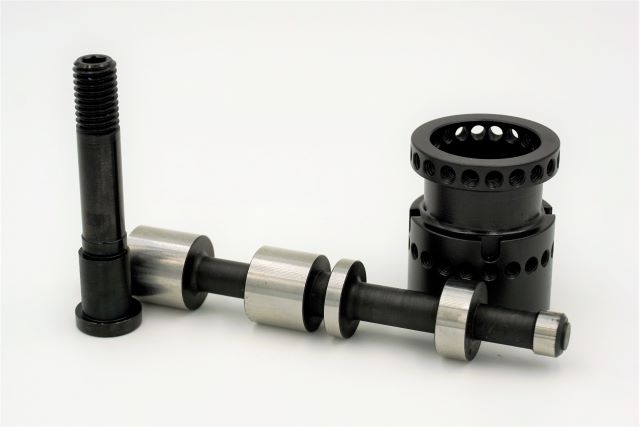Precision machined components made from ferrous materials (stainless-steel alloys) can specify black oxide as a surface finish treatment to provide additional protection for the component parts.
What is Black Oxide?
Black oxide is a conversion coating that is produced through a chemical reaction when component parts are dipped in an alkaline salt solution (which is usually heated). The reaction between the stainless-steel alloy and the solution creates magnetite on the surface of the part. The magnetite acts as a protective barrier, keeping moisture from corroding the surface of the alloy. The magnetite is a black color, hence the name of “black oxide”.
The solution for this process is slightly different depending on the metal it will be applied to. It can be applied in cold, room temperature or hot processing methods, and may require pre-treatment of the components, depending on the component requirements.
Another advantage of black oxide is that the process only creates an extremely thin layer of magnetite to create the moisture barrier. Typical thickness is 5-10 millionths of an inch (.000005” – .000010”). This means that the process does not affect the dimensional stability of the part. Another advantage is that no metal is removed or deposited from the component surface during processing. And unlike painting or plating surface treatments, black oxide will not chip or flake.
An after-finish treatment (oil, wax or lacquer) can also be applied which changes the surface finish from satin to glossy, depending on the final part application and aesthetic requirements. The after-finish can also offer improved lubrication characteristics which can aid in smoother running of components, and easier connections to mating components. The oil also enhances the protection against corrosion. When Black Oxide is not specified with any after finish treatment, usually the treatment process with be completed with oil.
Applications Where Black Oxide can be Specified
- Components used in military applications where MIL-DTL-13924D specifications must be met.
- Surgical instruments in light-intensive environments to reduce eye fatigue.
- For gears, fasteners and hardware used in assemblies where corrosion resistance is required.
- Hardware used in architectural and furniture assemblies where the black color adds to the aesthetic appeal of the final product.
Important Factors to Consider if Specifying Black Oxide
- Duration of protection required
- Indoor or outdoor application
- Desired finish appearance (matte or glossy)
- Environment (humidity, vapor, temperature)
- Final use of the product
Testing Options if Required
There are several testing options for a black oxide finish. If any of these are required, they will be specified on a part drawing, and usually additional time and cost will be incurred for this testing.
- Smut Test- this process will determine if any of the black powdery residue wipes off the part when rubbed by hand. This test is conducted before an after-finish is applied.
- Relative Humidity – this process will test for corrosion resistance using the ASTM D 2247 Standard Practice for Testing Water Resistance of Coatings in 100% Relative Humidity.
When You’re Ready to Discuss Your Next Precision Machined Project
Pioneer Service clients in a wide variety of industries specify black oxide for a number of their precision machined components, including Appliance/White Goods, Automotive, Firearms, Military/Dept of Defense, Aerospace, Oilfield/Energy Distribution, Hardware/Fastener, Equipment Manufacturers and Medical.
We work with a variety of qualified partners to complete the black oxide treatment of precision machined components in our facility. We utilize vendors who are ISO9001 and AS9100 (NADCAP) certified, depending on the project requirements.
For any questions about black oxide and the use of the finish on your next precision machined project, please contact our team at contact@pioneerserviceinc.com .



